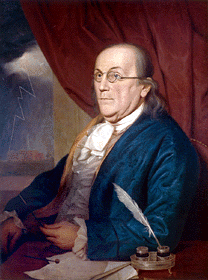|
|
Introduction
Introduction
- Making Connections
- The Republic of Science
- Scientist and Statesman
A Bifocal View
- Franklin the Friend
- Enduring Legacy
|
Long before he was a Founding Father, Benjamin Franklin was world famous
for his work in electricity. He challenged the prevailing idea that there were two distinct kinds of electrical "fluid."
He proposed that there is one kind of electricity and two charges, which he called positive and negative, the terms we still use. He invented the lightning rod—which we also still use—and so found a highly practical use for another theory, that lightning and electricity are the same thing. To prove the theory, he pulled electricity from the sky with a kite and a key,
a feat that gave him the status of a Yankee Prometheus.
But Franklin never thought
of himself as a scientist. The word scientist did not enter
the language until some fifty years after his death in 1790. There was no such profession in the eighteenth century, a time that saw the creation of whole new fields of science: electricity, geology, paleontology, modern chemistry.
How, then, did scientific
investigators like Franklin view themselves? How did they wish
to be viewed?
|
|

Benjamin Franklin, by Charles Willson Peale (1741-1827),
Oil on canvas, 1789. Courtesy Historical Society of Pennsylvania, Philadelphia, Pennsylvania
|
The Smithsonian National Portrait Gallery raises these questions in
Franklin & His Friends, an exhibit that opened in the spring of 1999. It is a collection of portraits of Benjamin Franklin and his American colleagues in "natural philosophy," as science was then called. They were a far-flung and rather diverse group of men who
had in common an interest in the workings of the
natural world. Many of them overcame the difficulties
of distance and held together a circle of friendship through correspondence.
Back
Start, Franklin |
 |
 |
Next
Making Connections |
|



